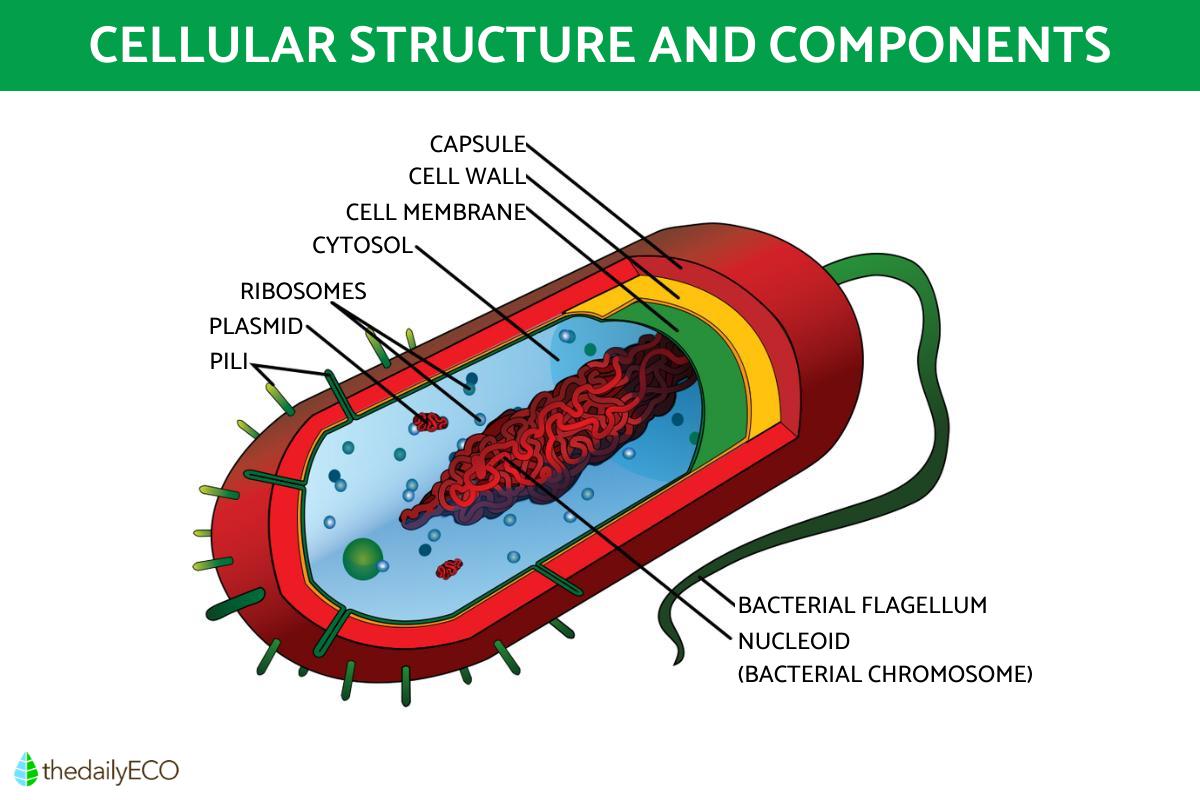Kingdom Monera Definition and Characteristics in Biology

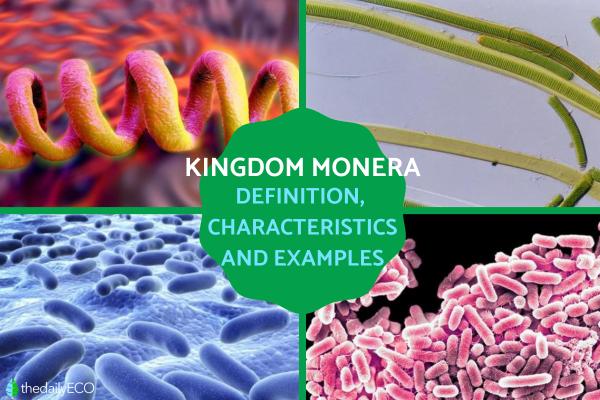
One of the most important ways to understand living beings is to classify them. Since there are so many types of organism, we choose various metrics by which we can group them. Some are larger than others. For example, we make a clear distinction between plants and animals. Not all distinctions are so easy to make, especially when we investigate them on a cellular level. For this reason, biology has endeavored to categorize living organisms in a process known as taxonomy which is always evolving and changing according to new data. One of the largest taxonomic ranks is known as the kingdom. The kingdom of Monera is one of the five kingdoms.
At thedailyECO, we understand more about how we organize nature with our guide to the kingdom Monera. We look at the definition, characteristics and examples of Monera in biology, as well as important information on how the kingdom itself is ranked.
What is the kingdom Monera in biology?
Biology is the scientific study of life. As with all scientific study, it is an ongoing process which is constantly being refined and updated. This applies to all the small intricacies in terms of the behavior and appearance of organisms, but it also includes macro approaches to the study of life.
The idea of having kingdoms of living beings is not new. In fact, it was an idea which was first codified by the Ancient Greeks. Originally, this was divided into the two fundamental kingdoms of living and non-living beings. This evolved to a broader definition which has led to there being more kingdoms. Although some have proposed there to be as many as 8 kingdoms, the 5 kingdoms of nature is the most commonly accepted worldwide.
Proposed in 1969 by ecologist Robert Whittaker, the five kingdom system incorporates the following:
- Kingdom Monera
- Kingdom Protista (Protoctista)
- Kingdom Plantae
- Kingdom Fungi
- Kingdom Animalia
The kingdom Monera (from the word ‘moneres’ which means ‘single’) or Monera kingdom is made up of prokaryotic organisms. These are unicellular beings without a defined nucleus and with sizes between 3 and 5 μm, the most common of which are types of bacteria.
The Monera kingdom is made up of the oldest, most widespread and numerous organisms on Earth. They are present in all types of ecosystems, both aquatic and terrestrial. They are organisms whose form of nutrition can be autotrophic or heterotrophic (parasitic or saprophytic). These beings can be found in isolation or colonies. This is a consequence of cell division without subsequent separation of the descendant cells.
Kingdom Monera characteristics
For those who follow the 5 kingdom system of classification system, the kingdom Monera is a classification of unicellular organisms. The following are the characteristics common to the living beings found in the kingdom Monera:
- Different shapes: cocci, bacilli, vibrios, spirilla, and some can even change shape during their development (pleomorphic), depending on the medium they occupy.
- Glycolysis: as they are unicellular organisms with modest energy needs, they rely almost entirely on a process known as glycolysis. This is the oxidization process of glucose molecules to obtain energy from proteins, carbohydrates, and fats. Some bacteria obtain their carbon from inorganic carbon sources, but pathogenic bacteria are heterotrophic. This means they obtain their nutrients (including nitrogen) from both organic and inorganic sources.
- No organelles: one of the common characteristics of the Monera kingdom is the fact they do not have mitochondria, lysosomes, plasmids, Golgi apparatus, endoplasmic reticulum or centrosome, i.e. they have no organelles within their cells. Learn more about what this entails with our guide to cell organelles.
- Asexual reproduction: they carry this out by binary fission or excision.
- Effect on their environment: these unicellular organisms are decomposers and mineralizers in the environment they inhabit.
Now that we know the basic characteristics of the Monera kingdom, we can find out more detail about what it entails. Specifically, we are going to discover the components of this kingdom and see examples of them in biology.
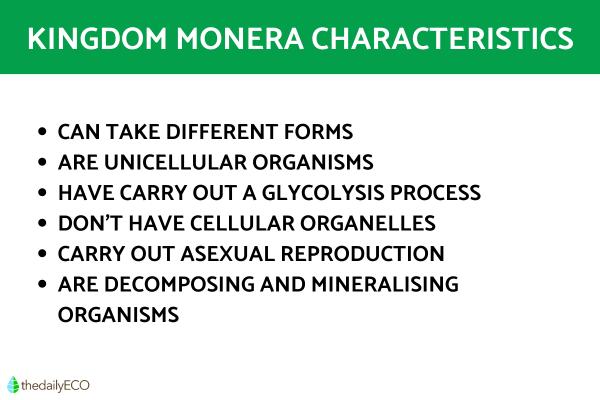
Cellular structure of the kingdom Monera
All organisms in the kingdom Monera are unicellular. Although this means they are relatively simple organisms which lack organelles, they are still made of various components. They are the following:
- Bacterial capsule: some bacteria have a bacterial capsule which functions as a protective structure. It is found outside the bacterial wall and is composed of polysaccharides and amino acids. It serves to adhere to surfaces and to resist phagocytosis by macrophages or other types of microorganisms. It is usually present in parasitic forms, such as Mycobacterium tuberculosis or Diplococcus pneumoniae.
- Bacterial wall: although it is not present in all prokaryotic cells, it is a very important structure. It provides the cell with shape and keeps the structure intact and stable, in turn protecting it from osmotic stress situations. It is composed of polysaccharides, proteins, lipids and glutamic and diaminopimelic acids. The cell wall is also important in the context of pathogenicity because it protects the bacteria from enzymes that can degrade it. This is also because it presents antigenic determinants. This is especially so in Gram-negative bacteria as they are responsible for toxicity in some diseases such as salmonella.
- Plasma membrane: located inside the limit delineated by the cell wall. It is fine and elastic, acting as a mechanical limit. It has selective permeability, serves for the transport of nutrients and waste, and for the detection of signals from the environment. Since these organisms lack internal organelles, the plasma membrane is where metabolic processes such as respiration and photosynthesis are carried out.
- Cytoplasm: fluid or semifluid aqueous medium consisting of vitamins, salts, enzymes, carbohydrates, soluble proteins, lipids and nucleic acids. The cytoplasm is granular in consistency due to the presence of a high number of ribosomes.
- Periplasmic space: a region in the cell wall of Gram-negative bacteria, located between the outer and cytoplasmic membrane. It is very important in organisms from the kingdom Monera. It is composed of a periplasmic fluid that contains hydrolytic enzymes and binding proteins for nutrient uptake and processing.
- Absence of nucleus: the nucleic acid (DNA in double helix and circular molecule structures) is in an area called the nucleoid that is more electron dense than the rest, but lacks a membrane around it.
- Bacterial endospore: typical structure of bacteria that forms inside and serves to resist adverse conditions.
- Pili and fimbriae: some bacteria have fimbriae or different types of hair which are important for adhesion to surfaces.
- Flagella: prokaryotic cells that move do so through structures called flagella, different from those that a eukaryotic cell may present.
- Ribosomes: the ribosomes of bacteria have a function of protein synthesis. They are different from those of eukaryotic cells in the sedimentation coefficient, since prokaryotes have a coefficient of 70. This is the same as those of mitochondria and chloroplasts, something which supports the theory of the bacterial origin of these organelles.
- Inclusion bodies: a kind of organelles that can be used for magnetic orientation, to store reserves of carbon, nitrogen or phosphorus and for buoyancy (like gas vacuoles, which allows them to rise or fall in an aqueous environment).
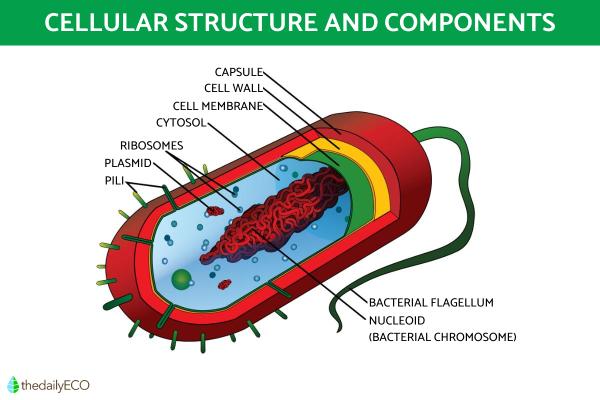
Classification of the kingdom Monera
The kingdom Monera has experienced various changes. It previously was said to contain the following two types of organism:
- Eubacterial organisms
- Archaebacteria organisms
It was later concluded that the latter had a completely independent evolutionary history from bacteria and came to be considered as two separate groups known as archaea and bacteria. For this reason, the classification of the kingdom Monera is the following:
Archaea (previously ‘archaebacteria’)
They are the oldest existing prokaryotes on Earth. They are characterized by inhabiting environments with extreme conditions, e.g. hot springs and areas of high salinity. They can do so thanks to a cell wall with a characteristic structure that allows them to survive such conditions.
They share certain characteristics both with bacteria, such as their prokaryotic cell structure and their types of metabolism, the latter including nitrogen fixation or denitrification. They also share similarities to eukaryotic cells such as having autotrophic nutrition, a lack of peptidoglycans in the cell wall and RNA polymerases with multiple polypeptides. They display nucleotide sequences in their unique tRNA and rRNA.
Bacteria (previously ‘eubacteria’)
The name eubacteria means ‘true bacteria’ and they have the typical characteristics mentioned above. These include having the following:
- Rigid cell walls composed of peptidoglycans.
- Locomotion with the help of flagella.
- Presence of pili on the cell surface which help in sexual reproduction and also allow pathogens to attach themselves to a host.
Cyanobacteria
Even though we know they are not a type of algae, they are still commonly known as blue-green algae because they were considered to be so for such a long time. They are actually the only prokaryotic organisms capable of oxygenic photosynthetic processes. They are the largest prokaryotic organisms, being able to reach dimensions of up to 60 micrometers.
Due to their ability to carry out photosynthesis, many Cyanobacteria were initially classified in the kingdom Plantae (commonly known as plants). Learn about photosynthesis in plants with our guide to chlorophyll and their function.
Some cyanobacteria are also capable of fixing nitrogen and have developed specialized cells called heterocysts. These cells are able to combine this process with that of oxygenic photosynthesis. They do this as they would otherwise not be able to take place in the presence of oxygen. As prokaryotic organisms, the presence of gas vacuoles in some types helps to aid buoyancy.
The characteristic color of some of these organisms is given by the combination of phycobilin and chlorophyll a, but other species can be colored:
- Green
- Brown
- Yellow
- Black
- Red
This is due to other pigments such as carotenoids and phycoerythrin. Although most cannot exist in the absence of light, certain species can if there is a sufficient supply of glucose to serve as a carbon and energy source.
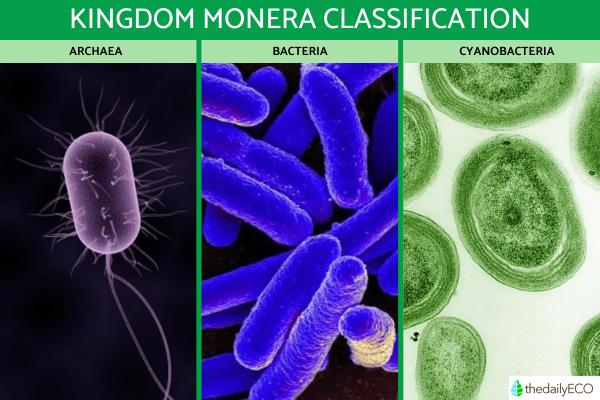
Examples from the kingdom Monera
As the kingdom Monera only contains unicellular organisms, some may consider them not as diverse as multicellular organisms. However, the kingdom Monera is both the most ancient and the most numerous of all the kingdoms. It is difficult for us to perceive this since they are so tiny, but looking at some examples of the organisms in the kingdom Monera might help:
- Archaea: Haloquadratum walsby, haloarchaea, Ignicoccus hospitalis (which establishes symbiotic relationships) or Pyrolobus fumarii (which can live in extreme temperature conditions).
- Bacteria: Escherichia coli (present in the intestinal flora of humans and helps in the digestion of food) or Clostridium botulinum (responsible for the production of botulinum toxin, which can cause botulism).
- Blue-green algae or cyanobacteria: Anabaena azollae (maintains a symbiotic relationship with the aquatic fern genus Azolla) or Nostoc sphaericum.
As you can see, the diversity of the plant and animal kingdoms is great. There are many differences, but some fundamental factors are shared between them. Find out more with our article on the difference between plant and animals cells.
If you want to read similar articles to Kingdom Monera Definition and Characteristics in Biology, we recommend you visit our Biology category.







